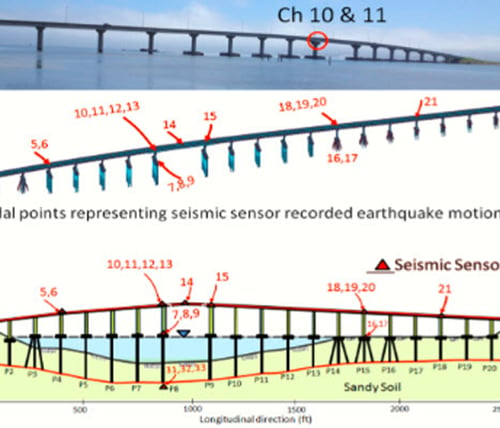Do we really know the foundation performance during liquefaction?

Author: Bede Yoo
Publish Date: 12 Sep, 2019
In 2010, the M8.8 Maule Chile earthquake impacted most of central Chile. It was catastrophic to say to least resulting in over 500 lives lost, millions of home lost and over USD 30 billion in economic losses.
It remains as a stoic reminder for all, especially geotechnical engineers, that we have yet to master and navigate the earth.
Why the interest with Mataquito Bridge?
Understanding the behavior of the structure under liquefaction has become a personal challenge for geotechnical engineers. They needed to understand why some structures failed while others remained unscathed. The community theorized most likely due to the effects of liquefaction-induced lateral and vertical ground displacement, which caused large ground deformations that impose kinematic loads on the pile foundations. Of the bridges that were subjected to liquefaction, the Mataquito Bridge remained nearly unscathed while its sister bridge, Juan Pablo II showed severe damages along the abutments.
The Mataquito Bridge is a 320 m-long, 8-span, reinforced concrete bridge that crosses the Mataquito River close to the Pacific Ocean. Four drilled shafts of circular section supported each abutment of this bridge. The study showed lateral spreading occurred around both north and south bridge bents, but the deformations were virtually zero, while just outside the pile caps these deformations were in the order of 1 to 2 m.
Is there a discernible reason?
Despite evidence of liquefaction at both abutments of this bridge, its structure remained undamaged and functional, and the residual displacements of the bridge foundations were insignificant. The bridge remained in use after the earthquake.
The liquefiable material confined to the upper 10 m of the soil deposit mostly because the material was held by competent soils. Given that the piles’ length it probably provided enough vertical and lateral support for the piles to resist the vertical and lateral loads, despite the occurrence of liquefaction at shallow depths.
One of Christian Ledezma's objective was to compare the numerical data and field observations found on the Mataquito Bridge. His study involved utilizing multiple methods to discern the most realistic dynamic results based on the seismic record. Checking and comparing the performance, geometry, and geotechnical properties. Objectively, there are merits and demerits to every method; however, the one consistency was evaluating these cases in 3D.
"Ground failure case studies have been the source of the most important advances in geotechnical earthquake engineering over the past 50 years. Documented case histories from the 2010 M8.8 Maule Chile earthquake will, if carefully studied, further advance this field. The 2010 M8.8 earthquake in Chile showed that liquefaction-induced soil-foundation-structure interaction problems are still far from being completely understood." (Ledezma, 2013)
ROI of midas GTS NX
- Intuitive User Experience for complex geometric and structural modeling.
- Structural interfacing for refined soil-foundation interaction.
- Control of seismic data exportable from Microsoft suite.
- Mesh shape, refinement and speed.



Add a Comment